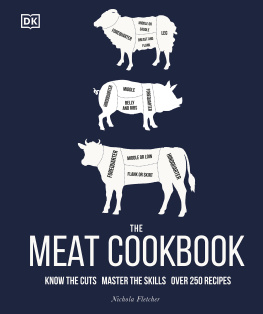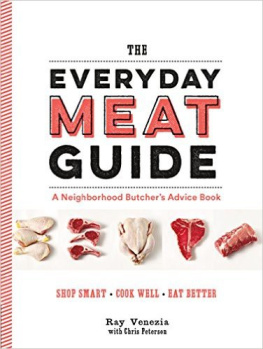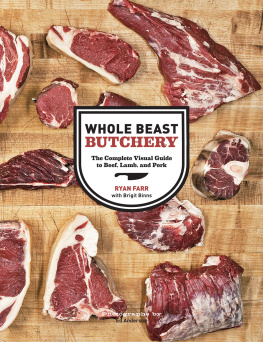THE
BUTCHERS
APPRENTICE
ALIZA GREEN
THE EXPERTS GUIDE TO SELECTING, PREPARING, AND COOKING A WORLD OF MEAT
WITH PHOTOGRAPHY BY STEVE LEGATO


CONTENTS
INTERVIEWS WITH THE MASTERS
ILLUSTRATED TECHNIQUES
VEAL

INTRODUCTION TO MEAT
In The Butchers Apprentice, I explain the complex nature of producing animals for their meat and how that meat can be prepared so that you can make thoughtful, economical, and nutritionally conscious choices at the market and have the skills to prepare that meat to bring out its best. To write this book, I interviewed breeders, farmers, ranchers, butchers, meat cutters, processors, and other meat industry professionals, and visited as many of their farms and businesses as possible to get a nuanced picture of their lives and work. I asked endless questions to learn more about the challenges they face every day in bringing good meat to market and preparing it properly and safely to enhance its inherent flavor and texture.
The book includes as many meat-cutting techniques as I could find room for. Each technique includes step-by-step instructions illustrated by large, clear photos to give you the confidence to understand the characteristics of various meats, just where on the animal they come from, the nature of individual cuts, and how best to cut, trim, store, and cook the meats, poultry, and game covered here.
Youll meat the people behind the producthardworking, dedicated individuals and companies who care deeply about the animals they work withto better understand what makes good meat. Everyone that I spoke to was generous in sharing his or her special knowledge and valuable perspective. Youll find a broad range of viewpoints in this book, because there is no one right way to eat meat and no one person has all the answers. The more we know about the meat we eat, the better the choices we can make.

WHAT IS THE MEAT WE EAT?
Meat is mostly composed of bundles of muscle cells called fibers that are made up of two proteins, actin and myosin, which work together to give meat its structure. The filaments are bound together by two types of connective tissue: collagen, or gristle, which is broken down into gelatin by slow cooking, and rubbery elastin, which doesnt break down no matter how long the meat is cooked. Organs such as liver and kidneys, and other parts including blood anddepending on the cultureears, tail, intestines, tendons, feet, and even eyeballs are also eaten and may be known as offal, viscera, organ meats, or variety meats. Many organ meats are high in cholesterol. The size and thickness of the muscles determine the texture of the meat, so the meat of young animals, such as lamb or suckling pig, and animals that exercise less, such as domestic turkey and penned rabbits, will be more tender.
Collagen is a long, stiff protein made up of three separate molecules twisted around each other, making for a very stable structure that is difficult to break down. The more collagen contained in a piece of meat, the tougher it will be to cut and chew. Skin and tendons are mostly collagen, and weight-bearing muscles that are in constant use, such as the legs, chest, and rump of cows and pigs, contain the most collagen.
FAT HOLDS FLAVOR
Fat is a concentrated source of energy stored in and around muscles and is key to flavor. When fat is heated, it melts, lubricating muscle fibers and helping to keep the meat moist. Fat content varies greatly depending on species, breed, sex (females are higher in fat than males), method of raising (pasture-grazed and wild animals are lower in fat), the particular cut, trim, and cooking method. Cuts that contain the most fat come from parts that arent used as much. Ribs are fatty, for example, and outer leg is quite lean.
Grain-finished beef cattle and lamb will be higher in fat while pastured cattle, venison, and bison will be quite lean. Lean meats may have extra fat added by wrapping in sheets of fatback or bacon, inserting small sticks of fat called lardons into the meat, slow-cooking in fat as for confit, or by grinding meat with extra fat as for sausage. Fat quantity also depends on how carefully the meat has been trimmed and may be removed after cooking. Chill fatty cuts overnight after cooking and then remove the solidified fat. Pork has been bred to be far leaner than it was in the past, but with leanness comes the tendency to become dry, so the pendulum is swinging back.
Fat dispersed between the muscle fibers is known as marbling. Fat also develops between muscles and underneath the skin (pork fatback). The hard saturated fat surrounding inner organs, especially kidneys (beef and mutton suet and pork leaf lard), is prized for deep-frying and baking because of its high melting and smoke point.
RED, WHITE (AND BLACK) MEAT
Meat is often classified as red or white, depending on the amount of myoglobin, which turns red when exposed to oxygen, is contained in its muscle fiber. Color varies with age, so very young lamb will be pale pink, full-grown lamb will be cherry red, and mature mutton will be dark purplish red. Some pork muscles are darker and close to red in color, like the tenderloin butt, while others are lighter, like pork rib. In general, the older the animal, the darker its flesh and the yellower its fat, though fat color also depends on diet, as young grass-fed beef cattle will also have yellowish fat.
THE COLOR OF RED MEAT
Fresh-cut beef is purplish in color. Oxygen from the air reacts with pigments in the beef and turns it cherry red. The surface color of lamb will be dark cherry-red; pork will be pinkish tan; and veal will be pale pink (for formula-fed veal) to rose colored (for pastured veal). The color of fresh-cut meat is highly unstable and short lived, especially if the meat has been ground, so the interior of a package of ground beef may be grayish brown because oxygen doesnt penetrate below the surface. This is not an indication that the meat is spoiled.
FROM THE FIELD TO THE TABLE AND THE STEPS IN BETWEEN
Meat is produced by killing, or slaughtering, an animal, then separating the edible parts from those to be discarded (which vary from animal to animal and according to local culture and laws). Many cultures have special rituals and laws surrounding the killing of animals and preparation of their meat. In Judaism and Islam, pork is not eaten and animals must be conscious before slaughter, which is done with a sharp knife after saying a prayer. In Hinduism, cows are sacred and are not eaten.
Upon reaching a desired age or weight, livestock are transported to the slaughterhouse, a journey that understandably can be stressful, result in injuries, and have a negative effect on the quality of the meat. Animals from smaller, family-run farms may be slaughtered locally and with more care. The animals are usually stunned, then killed and immediately bled out. Next, the carcass is dressed: usually the head, feet, hide, excess fat, and viscera are removed, leaving muscle and bones.








